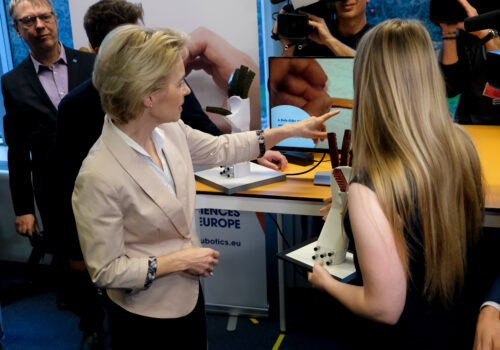
May 7, 2024 • 11:48 am ET
The Enrico Letta Report and the state of the EU’s Capital Market Union
Enrico Letta, former prime minister of Italy, recently delivered his report to the European Union (EU), entitled “Much more than a market: Speed, Security, Solidarity”. The report aims to significantly upgrade the EU Single Market and discusses the unfinished project of the Capital Market Union, which aims to harmonize the flow of capital within the bloc.
The EU’s economic weight in the world has declined substantially in the past few decades and its strategic position has weakened seriously as the geopolitical rivalry between the United States and China intensifies. Against that backdrop, one of the report’s main recommendations is to transcend the Capital Market Union to promoting a Savings and Investments Union instead. The aim is to mobilize savings and investments in EU countries, and the report proposes launching a variety of investment vehicles to facilitate retail and institutional investments in the EU economy and especially its green energy transition efforts. These include an EU-wide auto-enrollment Long Term Savings Product leveraging tax incentives by member states; enhancing the Pan-European Personal Pension Product; a European Long-Term Fund; as well as a European Green Guarantee facility to support bank lending to green energy projects. Unfortunately, this well-meaning proposal fails to tackle the underlying causes of the EU’s fragmented capital markets.
While the proposed funds and products may be worthwhile, it is difficult to assess their contributions to reviving EU economic growth until more operational details are forthcoming. Meanwhile, by emphasizing the use of tax incentives and guarantees, the report has downplayed the unglamorous but crucial tasks of harmonizing laws, regulations, market structures, and practices in twenty-seven member countries to forge a seamless European capital market where savings can flow to the best opportunities without internal barriers. The harmonization job is far more complicated than it sounds—involving the development of common rules or at least common and consistent standards for corporate laws. That includes bankruptcy and reorganization provisions, creditors’ ease in seizing and liquidating loan collaterals, tax procedures, supervision of markets and entities, accounting standards, trading rules including for shorting, investment rules for institutional investors such as pension funds, insurance companies and mutual funds, listing requirements including the languages used for prospectuses, etc. Turning all these national rules and regulations into a common EU rules book has run into strong resistance from vested interests in various countries, explaining the slow progress to date in advancing the Capital Market Union. However, without making much more headway in these nuts-and-bolts issues, the proposed European Savings and Investments Union will likely be slow in taking shape as well.
The report also singles out practices which hinder the channeling of savings to investments in the EU but does not get to the root causes of the problems or suggest ways to overcome the impediments.
Firstly, the report bemoans the fact that while the EU is home to €33 trillion ($35.4 trillion) of private savings, annually €300 billion ($321 billion) are being diverted to overseas financial markets, primarily to the United States, due to internal fragmentation. However, it does not recognize, and does not suggest ways to rectify, the fundamental factor attracting European savings to the much larger US stock market, which accounts for 54.5 percent of world market capitalization compared to large European markets at 15.7 percent. Investment flows to the United States primarily because of superior returns on American equity markets compared to those of the EU. Specifically, for the period 1900-2020, the average annual nominal return on US equities was 9.6 percent compared to 7.2 percent for Europe. So long as this remains the case, savings from the EU and the rest of the world will continue to be attracted to the United States, where foreign investors own 40 percent of the stock market. So the EU need both reforms and investment: structural reforms to make the EU economy more productive and its corporations more profitable will create more investment opportunities to deploy European savings at home—while more investment now could help improve EU productivity and growth prospects. Thus, while it is wise to find ways to increase investment in the EU, the problem is more fundamental than just the efficiency of capital markets.
The Letta report also points out the fact that EU households keep 34.1 percent of their savings in bank deposits, not investing those in stock and bond markets. It is important to realize that this behavior of European households reflects their cultural and traditional preference for loss avoidance over capital gains with risk. As such, a more developed Capital Market Union may encourage somewhat more allocation from bank deposits to portfolio or direct investments, but that would not substantially change the loss-avoiding investment behavior in the near term. Instead, it is more useful for policy makers in the EU to find ways to create a business environment for EU banks which receive an important part of its funding from retail depositors to invest the proceeds more productively.
Relative to US peers, EU banks have posted very low returns on assets (ROA) (of 0.4 percent vs. 1.4 percent for the United States) as well as low returns on equity (ROE) (fluctuating between 2-6 percent, about half of the US level). Consequently, market valuation of EU banks has been much lower than that of US banks: the price to book ratio of EU banks in 2014-2021 averaged 0.79x compared to 1.53x for US banks. In short, helping EU banks become more efficient and profitable—for example by launching the European Deposit Insurance Scheme (EDIS) to complete the Banking Union—would probably do more to support EU economic growth than trying to get EU households to change their investment behavior from bank deposits to market investments.
In conclusion, in highlighting the inefficiency of EU capital markets and proposing several products and policies for improvement, the Letta report has focused attention to the need to complete and upgrade the Capital Market Union, and the Single Market in general, to help the EU improve its economic performance in an era of geopolitical rivalry. However, much of the work requires attention to the detailed harmonization of economic and financial rules and regulations across the membership to promote a seamless market for savings and investments. These are unglamorous and painstaking tasks, but they need to be done.
Hung Tran is a nonresident senior fellow at the Atlantic Council GeoEconomics Center, a former executive managing director at the Institute of International Finance and former deputy director at the International Monetary Fund.
Further reading
Thu, Feb 8, 2024
Is the EU missing another tech wave with AI?
Econographics
By
Ryan Murphy
Policymakers in the United States and European Union view generative AI as one of the technological “commanding heights” of the coming decade. Are EU startups falling behind on funding?
Image: “European flags in front of the European Commission headquarters in Brussels, Belgium. ( Motion Blurred on flags)”







